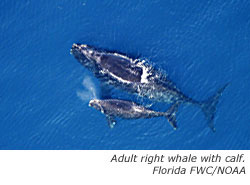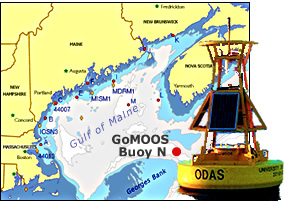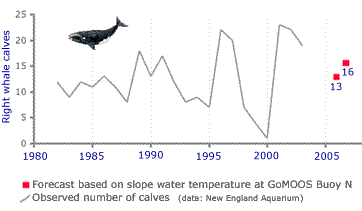Environmental Prediction in the Gulf of Maine
Forecast of North Atlantic right whale births

Introduction
With only some 350 individuals alive today, the North Atlantic right whale is critically endangered. Scientists recently discovered that a “chain reaction” of changes in the atmosphere and the ocean ultimately affects the birth rate of right whales. Using computer models developed by the scientists, GoMOOS now provides forecasts of North Atlantic right whale births based on data from GoMOOS Buoy N and other sources.

Forecast of right whale births
Located in the Northeast Channel, GoMOOS Buoy N measures water temperatures at depths to 180 meters (590 feet). Scientists have determined that the birth rate of right whales can be predicted based on the temperature of water deep in the Northeast Channel. The temperature indicates which of two deep water masses is entering the Gulf of Maine from the continental slope. In turn, these water masses influence the whales' food supply, which fuels their reproduction.
2006: 13 births predicted
2007: 16 births predicted
Update: We are currently working on the forecast for 2012 as well as updating the previous years forecasts and the actual births reported. Stay tuned!
Sign up to get new forecasts by email

What is the "chain reaction" from atmospheric changes to right whale births?
|
Click a button at left to see how changes in the atmosphere affect the number of right whales born approximately two years later.
Graphics, left to right:
|


